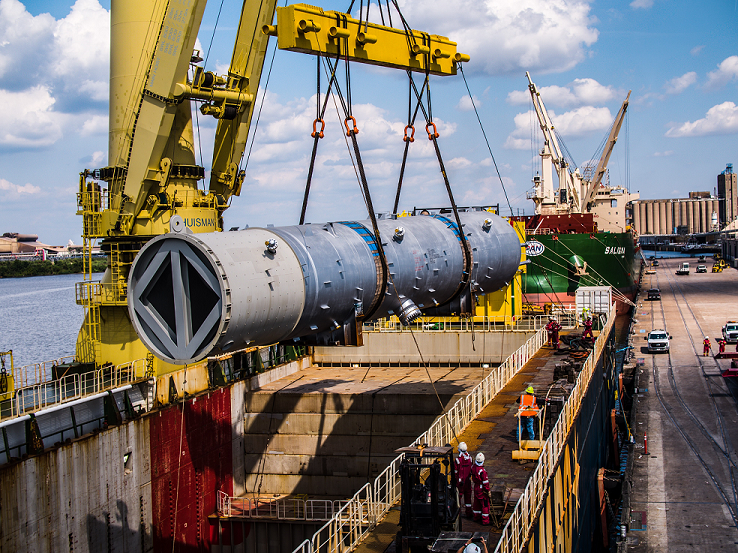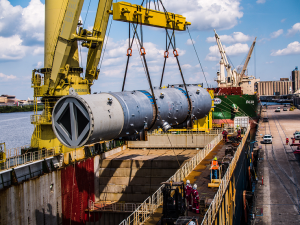Efficient cargo handling and stowage are critical aspects of maritime logistics, ensuring the safe and optimized transportation of goods. Proper cargo management not only enhances operational efficiency but also ensures compliance with international safety standards, particularly the International Convention for the Safety of Life at Sea (SOLAS). In this article, we will explore key questions frequently asked about cargo stowage, handling, and related concepts, providing in-depth insights while highlighting relevant SOLAS chapters to ensure safety and regulatory adherence.
Refinery Equipment Cargo Offloading from Heavy Lift Vessel. Ship in Balance. Photo Credit: UTC Overseas, Inc.
What is Cargo Stowage, and Why is it Important?
Cargo stowage refers to the strategic arrangement and securing of goods within a vessel to ensure stability, safety, and optimal use of space. Proper stowage prevents cargo shifting during transit, which can lead to accidents, damage, or even capsizing. It also plays a vital role in maintaining the vessel’s trim and stability, ensuring safe navigation.
Related SOLAS Chapters:
- Chapter VI (Carriage of Cargoes and Oil Fuels): This chapter outlines requirements for the safe stowage and securing of cargoes, including bulk and non-bulk materials, to prevent hazards during transit.
- Chapter XII (Additional Safety Measures for Bulk Carriers): Focuses on the structural safety and cargo handling of bulk carriers, emphasizing the importance of proper stowage to avoid structural stress.
What are the Key Principles of Efficient Cargo Handling?
Efficient cargo handling involves the safe loading, unloading, and transfer of goods while minimizing delays and maximizing space utilization. Key principles include:
- Proper planning and coordination between ship and port personnel.
- Use of appropriate equipment and technology.
- Adherence to safety protocols to prevent accidents and injuries.
Related SOLAS Chapters:
- Chapter VII (Carriage of Dangerous Goods): Provides guidelines for handling, stowage, and segregation of dangerous goods to prevent risks such as fire, explosion, or chemical reactions.
- Chapter II-2 (Construction – Fire Protection, Fire Detection, and Fire Extinction): Includes provisions for fire safety during cargo handling, especially for hazardous materials.
How Does Cargo Stowage Impact Vessel Stability?
Improper stowage can compromise a vessel’s stability by affecting its center of gravity, leading to listing or even capsizing. Proper weight distribution and securing of cargo are essential to maintain stability, especially in rough seas.
Related SOLAS Chapters:
- Chapter II-1 (Construction – Structure, Stability, and Machinery): Sets standards for vessel stability, including requirements for cargo distribution and securing to ensure safe navigation.
- Chapter V (Safety of Navigation): Emphasizes the importance of maintaining stability through proper cargo management to avoid navigational hazards.
What are the Risks of Improper Cargo Securing?
Improperly secured cargo can shift during transit, causing:
- Damage to the cargo and vessel.
- Risk of injury to crew members.
- Environmental hazards, such as spills of dangerous goods.
Related SOLAS Chapters:
- Chapter VI (Carriage of Cargoes and Oil Fuels): Requires cargo securing manuals and procedures to ensure safe stowage and prevent shifting.
- Chapter III (Life-Saving Appliances and Arrangements): Highlights the importance of securing cargo to prevent obstructions during emergency evacuations.
How Does SOLAS Ensure Safe Cargo Handling and Stowage?
SOLAS provides a comprehensive framework for safe cargo handling and stowage through:
- Mandatory cargo securing manuals.
- Requirements for cargo documentation and declarations.
- Guidelines for handling hazardous materials.
Related SOLAS Chapters:
- Chapter XI-2 (Special Measures to Enhance Maritime Security): Includes provisions for securing cargo to prevent security threats, such as smuggling or terrorism.
- Chapter XIV (Safety Measures for Ships Operating in Polar Waters): Addresses cargo handling challenges in extreme conditions, ensuring safe stowage and transport in polar regions.
What Technologies are Enhancing Cargo Handling and Stowage?
Modern technologies, such as automated stowage planning software, IoT-enabled cargo tracking, and advanced securing systems, are revolutionizing cargo handling. These tools improve efficiency, reduce human error, and ensure compliance with SOLAS regulations.
Related SOLAS Chapters:
- Chapter IV (Radiocommunications): Supports the use of advanced communication technologies for real-time cargo monitoring and coordination.
- Chapter V (Safety of Navigation): Encourages the adoption of digital tools for efficient cargo planning and stowage.
Conclusion
To conclude, efficient cargo handling and stowage are essential for safe and optimized maritime logistics. By adhering to SOLAS regulations and leveraging modern technologies, shipping companies can ensure the safe transport of goods while minimizing risks and maximizing efficiency. Understanding the relevant SOLAS chapters, such as VI, VII, and XII, is crucial for compliance and operational excellence in the maritime industry.
In short, relevant SOLAS Chapters to Cargo Handling and Stowage:
- Chapter VI: Safe stowage and securing of cargoes.
- Chapter XII: Structural safety for bulk carriers.
- Chapter VII: Handling and segregation of dangerous goods.
- Chapter II-1: Standards for vessel stability.
- Chapter V: Safety of navigation through proper cargo management.
- Chapter XI-2: Security measures for cargo handling.
- Chapter XIV: Safety in polar waters.
Adhering to these guidelines ensures safe transport and regulatory compliance while leveraging modern technologies for enhanced efficiency.
Code of Safe Practice for Cargo Stowage and Securing (CSS Code)
Background
The accelerations acting on a ship in a seaway result from a combination of longitudinal, vertical and predominantly transverse motions. The forces created by these accelerations give rise to the majority of securing problems. The hazards arising from these forces should be dealt with by taking measures both to ensure proper stowage and securing of cargoes on board and to reduce the amplitude and frequency of ship motions.
In this regard, the Assembly adopted the Code of Safe Practice for Cargo Stowage and Securing (CSS Code) in November 1991 by resolution A.714(17). The Assembly recommended that Governments implement the Code at the earliest possible opportunity and requested the Maritime Safety Committee to keep it under review and amend it as necessary.In this regard, the CSS Code has undergone subsequent changes through the years as follows:MSC/Circ.664; MSC/Circ.691; MSC/Circ.740; MSC/Circ.812; MSC/Circ.1026; MSC.1/Circ.1352; MSC.1/Circ.1352/Rev.1.
Purpose
The purpose of the CSS Code is to provide an international standard to promote the safe stowage and securing of cargoes by:
- drawing the attention of shipowners and ship operators to the need to ensure that the ship is suitable for its intended purpose;
- providing advice to ensure that the ship is equipped with proper cargo securing means;
- providing general advice concerning the proper stowage and securing of cargoes to minimize the risks to the ship and personnel;
- providing specific advice on those cargoes which are known to create difficulties and hazards with regard to their stowage and securing;
- advising on actions which may be taken in heavy sea conditions; and
- advising on actions which may be taken to remedy the effects of cargo shifting.
In providing such advice, it should be borne in mind that the Master is responsible for the safe conduct of the voyage and the safety of the ship, its crew and cargo.
General Principles
All cargoes should be stowed and secured in such a way that the ship and persons on board are not put at risk.
The safe stowage and securing of cargoes depend on proper planning, execution and supervision.
Personnel commissioned to tasks of cargo stowage and securing should be properly qualified and experienced.
Personnel planning and supervising the stowage and securing of cargo should have a sound practical knowledge of the application and content of the Cargo Securing Manual.
In all cases, improper stowage and securing of cargo will be potentially hazardous to the securing of other cargoes and to the ships itself.
Decisions taken for measures of stowage and securing cargo should be based on the most severe weather conditions which may be expected by experience for the intended voyage.
Ship-handling decisions taken by the master, especially in bad weather conditions, should take into account the type and stowage position of the cargo and the securing arrangements.
Reference: https://www.imo.org/en/OurWork/Safety/Pages/CSS-Code.aspx


